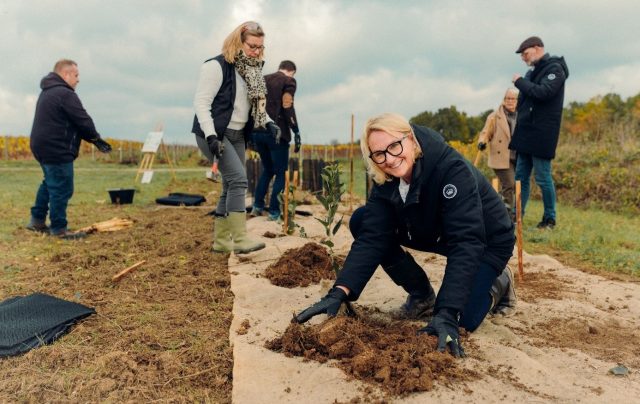Moët & Chandon drives biodiversity in Champagne
French Champagne producer Maison Moët & Chandon celebrated its fourth Biodiversity Day by launching 60 new planting projects in the Marne and Aube regions.

For the fourth edition of ‘Biodiversity Days’, Moët & Chandon initiated 60 new planting projects with their winegrowing partners, supported by the Marne Chamber of Agriculture, the FEADER (European Agricultural Fund for Rural Development), and the Grand Est region.
By unifying its employees, winegrowing partners, and public authorities, Moët & Chandon aims to plant one kilometre of tree hedges on two agricultural plots owned by a winegrower partner in the Côte des Blancs. The planting will link two reservoirs of biodiversity – the ‘Saran Forest’ and the ‘Montagne de Reims Forest’ – creating more natural habitats for animal and plant species to move and feed and ensuring their natural lifecycle.
In 2025, the initiative’s total of planted hedges will reach 55 kilometres, which represents 50% of the objective of 100 kilometres by 2027. The project represents a collective contribution to the Natura Nostra movement, the producer’s overall biodiversity programme.
Sibylle Scherer, CEO and president of Moët & Chandon, said: “Preserving nature needs the mobilisation of all the players. The Maison works closely with the interprofessional organisations, its partners, and public authorities by sharing its innovations and best practices and driving meaningful changes in the Champagne region.”
A long-term commitment
Having committed itself to environmental protection for over twenty years, Moët & Chandon launched the Natura Nostra program in 2021 to fight climate change and restore biodiversity in the Champagne region. By creating ecological corridors with its communities, the producer contributes to establishing the balance between ecosystems, preventing soil erosion, and improving water retention.
Partner Content
Following the planting of 35 kilometres of hedges across its own estates, Moët & Chandon raised awareness about its Natura Nostra program to 2,400 of its winegrower partners. Many responded positively to the large-scale program and benefited from tailored support provided and operated by the Maison’s vineyard teams. The initiative includes a significant human resource to guide and support related projects, from environmental analysis, plot design, and species selection to assistance with funding applications for regional and European grants.
Feeding into the project, several expert groups have contributed their support and knowldge. The Grand Est region has launched the ‘Grand Est agroforesterie’ initiative, which provides partner suppliers and farmers with access to funding from the region and FEADER. The Marne Chamber of Agriculture contributed with its technical expertise. A renowned plant nursery, Pépinière Quatre-Champs ‘Forêts et Paysages’, selected local plant species to ensure healthy growth.
The planting projects also provide additional benefits beyond biodiversity. On plots situated in drinking water areas, hedges help preserve water quality. Additionally, double-row hedges planted on slopes improve soil stability, making the land more resistant to erosion during heavy rains.
In further projects, Moët & Chandon also collaborates with agroforestry experts to select plant species tailored to soil and regional geography. By diversifying species, the flowering period expands and provides an enhanced food supply for wild pollinators while visually embellishing Champagne’s landscapes.
Related news
South Africa makes strides in sustainability




